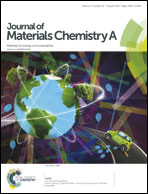Growth of 3D SnO2 nanosheets on carbon cloth as a binder-free electrode for supercapacitors
Abstract
Three-dimensional (3D) lamellar SnO2 is grown on a carbon cloth (CC) substrate (denoted as 3D lamellar SnO2/CC) through hydrothermal reactions and subsequent thermal treatments. The resulting 3D lamellar SnO2/CC can be directly used as an electrode in supercapacitors without the necessity for addition of either binder or conductive species, and achieves a specific capacitance as high as 247 F g−1 at a current density of 1 A g−1 within a potential window ranging from −0.6 to 0.3 V because of the unique porous structure accessible to electrolyte ions. In order to match the capacitive behaviors of 3D lamellar SnO2/CC in the two-electrode systems, reduced graphene oxide/carbon cloth (rGO/CC) is prepared by starting from GO. The rGO/CC and 3D lamellar SnO2/CC are respectively used as positive and negative electrodes to assemble an asymmetric supercapacitor. The device exhibits not only an excellent cycle stability (76.9% after 10 000 cycles at 3 A g−1), but also high energy density of 22.8 W h kg−1 at a power density of 850 W kg−1 under a cell voltage of 1.7 V. Moreover, the as-fabricated supercapacitor has green and environmentally friendly features because an aqueous neutral electrolyte is employed in it.


 Please wait while we load your content...
Please wait while we load your content...